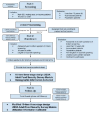Feasibility of an Emergency Department-based Food Insecurity Screening and Referral Program
- PMID: 40561966
- PMCID: PMC12208039
- DOI: 10.5811/westjem.40006
Feasibility of an Emergency Department-based Food Insecurity Screening and Referral Program
Abstract
Introduction: Food insecurity (FI) remains a pervasive issue in the United States, affecting over 12.8% of households. Marginalized populations, particularly those in urban areas, are disproportionately impacted. The emergency department (ED) holds potential as a vital outreach hub, given its diverse patient population and extensive service coverage. In this study we explore the feasibility of implementing an ED-based FI screening and referral program at an urban, academic teaching hospital. We aimed to assess the prevalence of FI among ED patients and evaluate the feasibility of a three- and six-week follow-up to assess patients' FI and related barriers to resource referral utilization.
Methods: This single-center, observational study was conducted at an urban, academic ED from 2018-2024. Initial FI screening was performed using a validated two-question survey adapted from the Hunger Vital Sign screening tool. Participants who screened positive were enrolled and completed the 10-item US Department of Agriculture Adult Food Security survey, received a food assistance guide, and were followed up at three- and six-week intervals to assess changes in FI status.
Results: Among 6,339 participants, 1,069 (16.9%) experienced FI, with the highest rates among Black non-Hispanic (24.7%) and Spanish-speaking participants (28.7%). Of the 1,069 participants who screened positive for FI, 630 (59.0%) were enrolled in the study. Of the enrolled participants, 161 (25.6%) completed the three-week follow-up phone calls, and 48 (7.6%) completed the six-week follow-up. The mean FI score for these 48 participants decreased from 6.67 (SD 2.68) at enrollment to 4.75 (SD 2.85) at the three-week follow-up (P < 0.001), and to 4.25 (SD 3.48) by the six-week follow-up (P < 0.001). Barriers to using the food resource guide, such as time constraints, transportation, and misplacement of resources, limited many participants' engagement.
Conclusion: This study demonstrated the feasibility and effectiveness of an ED-based food insecurity screening and resource referral program, associated with a significant reduction in food insecurity scores among participants. However, barriers such as time constraints, transportation issues, and misplacement of referral materials limited engagement. Addressing these barriers through tailored follow-up and systematic support systems, including universal screening during ED intake and personalized assistance, can enhance the program's accessibility and impact.
Conflict of interest statement
Figures



Similar articles
-
Emergency Department Comprehensive Social Risk Screening and Resource Referral Program.West J Emerg Med. 2025 Feb 25;26(3):387-395. doi: 10.5811/westjem.18578. West J Emerg Med. 2025. PMID: 40561970 Free PMC article.
-
Mortality Outcomes for Survivors of Cancer With Food Insecurity in the US.JAMA Health Forum. 2025 Jun 7;6(6):e251381. doi: 10.1001/jamahealthforum.2025.1381. JAMA Health Forum. 2025. PMID: 40540285 Free PMC article.
-
Learning together for mental health: feasibility of measures to assess a whole-school mental health and wellbeing intervention in secondary schools.Public Health Res (Southampt). 2025 Jun 25:1-18. doi: 10.3310/GFDT2323. Online ahead of print. Public Health Res (Southampt). 2025. PMID: 40580102
-
Nutritional interventions for survivors of childhood cancer.Cochrane Database Syst Rev. 2016 Aug 22;2016(8):CD009678. doi: 10.1002/14651858.CD009678.pub2. Cochrane Database Syst Rev. 2016. PMID: 27545902 Free PMC article.
-
Community screening for visual impairment in older people.Cochrane Database Syst Rev. 2018 Feb 20;2(2):CD001054. doi: 10.1002/14651858.CD001054.pub3. Cochrane Database Syst Rev. 2018. PMID: 29460275 Free PMC article.
Cited by
-
A Missed Meal, A Missed Diagnosis: Why Emergency Departments Must Lead on Food Insecurity Screening.West J Emerg Med. 2025 Jul 10;26(4):1120-1121. doi: 10.5811/westjem.47454. West J Emerg Med. 2025. PMID: 40794982 Free PMC article. No abstract available.
References
-
- Rabbitt MP, Hales LJ, Burke MP, et al. Household Food Security in the United States in 2022. 2023. [Accessed July 24, 2024]. Available at: http://www.ers.usda.gov/publications/pub-details/?pubid=107702.
-
- Hunger and Poverty in the United States | Map the Meal Gap. Feeding America; 2022. [Accessed July 23, 2024]. Available at: https://map.feedingamerica.org.
Publication types
MeSH terms
LinkOut - more resources
Full Text Sources
